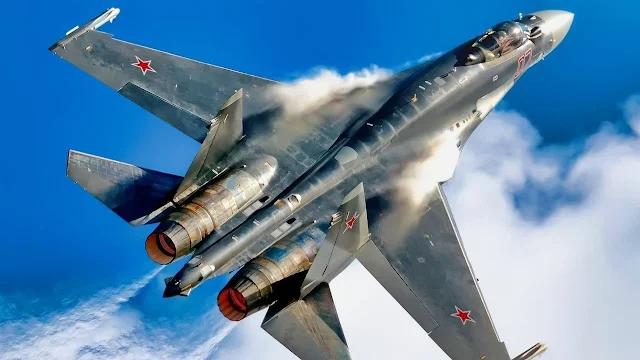A recent article published by Assahifa, a Moroccan outlet known for its close ties to the ruling elite in Rabat, inadvertently sheds light on one of the most significant geopolitical shifts in the Maghreb in decades: the entry into service of Russian-made Su-35 fighter jets in Algeria — one of the most advanced combat aircraft of our time.

In an article titled “After Being Rejected by Egypt and Iran… Satellite Images Reveal the Presence of Su-35 Fighters in Algeria”, the Moroccan media outlet delves into the arrival of these jets at an Algerian airbase with a tone that is both alarmist and revealing. While emphasizing that these aircraft had previously been turned down by Egypt and Iran, the piece unintentionally unveils deeper Moroccan anxieties — both military and diplomatic.
The Su-35: A Game Changer That Has Rabat Trembling
Originally destined for Egypt, the Su-35 jets were ultimately acquired by Algeria after Cairo backed out under Western pressure. Known for their exceptional agility, long-range capabilities, and powerful radar systems, the Su-35s dramatically shift the airpower balance in North Africa. Morocco, even with its upgraded F-16s, lacks any aircraft capable of matching the Su-35 in aerial combat or airspace dominance.
It is therefore unsurprising that Moroccan media would address the topic with unease. Assahifa, while attempting to downplay the jets’ significance by labeling them “old” or “rejected,” paradoxically underscores their precise location at Oum El Bouaghi airbase using satellite imagery — a move that highlights rather than conceals the gravity of the situation.
Assahifa: The Mouthpiece of the Makhzen’s Concerns
Despite presenting itself as a neutral news source, Assahifa is widely recognized as being aligned with the Moroccan monarchy’s strategic narrative. It often functions as a vehicle for preparing or testing public opinion ahead of political or military moves. In this light, the media’s heavy focus on Algeria’s Su-35s appears less a matter of information and more an exercise in managing perceptions — preparing Moroccans for a strategic disadvantage vis-à-vis Algeria.
This is not the first time Assahifa has masked Moroccan vulnerabilities with rhetorical smoke screens. On issues such as Western Sahara or diplomatic rifts with Spain, the outlet has consistently acted as a semi-official loudspeaker for the regime, shaping public discourse to deflect attention from internal shortcomings.
Algeria at the Heart of Morocco’s Media Strategy
What emerges from the article is a persistent Moroccan obsession with Algeria — an anxiety that extends beyond military hardware to a deeper structural unease. It is the fear of a neighboring state asserting strategic autonomy, investing heavily in national defense, and claiming a regional leadership role that Rabat struggles to counter.
The inclusion of broader regional references — such as the instability in Niger and Mali, or Algeria’s recent military reforms — reinforces this notion. Morocco’s unease is not just military. It is geopolitical. It is existential.
Conclusion: The Su-35 as a Symbol of Strategic Shift
Ultimately, while Assahifa’s article attempts to frame the Su-35 acquisition in technical terms, it reveals something far more telling: Morocco feels increasingly vulnerable in the face of Algeria’s military and diplomatic ascent. By integrating the Su-35 into its arsenal, Algeria not only bypasses Western pressures but also signals its readiness to embrace cutting-edge military technology — even at the cost of disturbing established balances.
And if Assahifa speaks so often of the Su-35, it’s because Rabat understands, deep down, that Algeria is no longer just taking the lead in rhetoric. It is doing so in the skies.
By Belgacem Merbah
Comments
Post a Comment